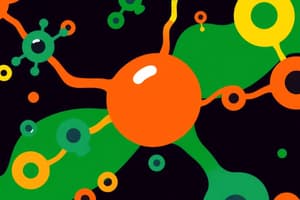Podcast
Questions and Answers
What is the primary function of carbohydrates in living organisms?
What is the primary function of carbohydrates in living organisms?
- Energy storage and supply (correct)
- Regulating hormonal activity
- Information storage
- Building cellular structures
What is a characteristic of monosaccharides?
What is a characteristic of monosaccharides?
- They are insoluble in water.
- They contain 3-7 carbon atoms. (correct)
- They cannot provide energy.
- They are composed of two sugar units.
Which of the following represents a disaccharide?
Which of the following represents a disaccharide?
- Glycogen
- Cellulose
- Sucrose (correct)
- Glucose
Which process involves the breakdown of a disaccharide into its monosaccharide units?
Which process involves the breakdown of a disaccharide into its monosaccharide units?
Which of the following polysaccharides is primarily used for energy storage in animals?
Which of the following polysaccharides is primarily used for energy storage in animals?
What type of fatty acids are linoleic and linolenic acids classified as?
What type of fatty acids are linoleic and linolenic acids classified as?
What is the structural role of triglycerides in the body?
What is the structural role of triglycerides in the body?
Which of the following is a characteristic of saturated fatty acids?
Which of the following is a characteristic of saturated fatty acids?
What is the primary function of triglycerides in the body?
What is the primary function of triglycerides in the body?
How are triglycerides decomposed?
How are triglycerides decomposed?
What is a characteristic feature of waxes?
What is a characteristic feature of waxes?
Which statement about phospholipids is true?
Which statement about phospholipids is true?
What structural form do steroids take?
What structural form do steroids take?
Which hormone is involved in egg development in the ovaries?
Which hormone is involved in egg development in the ovaries?
What role do bile salts play in digestion?
What role do bile salts play in digestion?
Eicosanoids are formed from which type of fatty acid?
Eicosanoids are formed from which type of fatty acid?
Flashcards are hidden until you start studying
Study Notes
Organic Molecules and Biomolecules
- Organic compounds are essential for life and include four main groups: carbohydrates, lipids, proteins, and nucleic acids.
Carbohydrates
- Defined as hydrated carbon molecules, they serve crucial roles in energy, energy storage, and cellular structure.
- Types include monosaccharides, disaccharides, and polysaccharides.
Monosaccharides
- Simple sugars that are water-soluble and hydrophilic.
- Composed of 3-7 carbon atoms, arranged in chains or rings.
- Important examples:
- Glucose: primary energy source for cells.
- Galactose: part of lactose and critical for cellular functions.
- Fructose: found in many fruits, often used in energy production.
Disaccharides
- Formed by two monosaccharide units through dehydration synthesis, which releases water.
- Hydrolysis breaks them down into their monosaccharide components.
- Important disaccharides:
- Sucrose: table sugar, composed of glucose and fructose.
- Maltose: formed from two glucose units, found in malted foods.
- Lactose: milk sugar, made up of glucose and galactose.
Polysaccharides
- Combinations of many monosaccharides, generally not water-soluble due to size.
- Serve as energy storage or structural units.
- Important polysaccharides:
- Starch: storage form of energy in plants.
- Glycogen: storage form of energy in animals, primarily in liver and muscles.
- Cellulose: structural component of plant cell walls, not digestible by humans.
Lipids
- Five essential classes of lipids play vital roles in biological systems.
Fatty Acids
- Building blocks of lipids.
- Saturated fatty acids have no double bonds and are solid at room temperature.
- Unsaturated fatty acids contain one or more double bonds, typically liquid at room temperature.
- Essential fatty acids, like linoleic and linolenic acids, are crucial for health but not synthesized adequately by the body.
Neutral Fats (Triglycerides)
- Composed of a glycerol backbone with three fatty acids.
- Nonpolar and serve as a primary energy source.
- Decomposed via hydrolysis; excess food is stored as triglycerides.
- Lipoproteins transport fats within the body.
Waxes
- Comprised of long-chain fatty acids and long-chain alcohols.
- Insoluble in water and provide protective coatings for feathers, fur, and skin.
- Example: Sebum, secreted by sebaceous glands, keeps the skin soft and prevents dehydration.
Phospholipids
- Major components of cell membranes and myelin sheaths in nerve cells.
- Composed of hydrophilic heads and hydrophobic tails, facilitating cellular structure and function.
Steroids
- Characterized by four interlocking hydrocarbon rings and are hydrophobic.
- Various types have unique functional groups attached, affecting their biological properties.
- Examples of steroids include:
- Cholesterol: vital for membrane structure and a precursor for other steroids.
- Cortisol: a glucocorticoid that regulates metabolism and stress responses.
- Aldosterone: a mineralocorticoid that regulates sodium and potassium levels.
- Estrogen: hormone involved in reproductive functions, including egg development.
Bile Salts
- Derived from liver secretions and stored in the gallbladder.
- Bile aids in fat digestion by emulsifying lipids, breaking down large fat globules into smaller droplets.
- The principal bile salt is sodium glycocholate.
Eicosanoids
- Lipids originating from 20-carbon fatty acids and comprised of a ring structure.
- Examples include:
- Prostaglandins: involved in inflammation and signaling.
- Thromboxanes: play a role in blood clotting.
- Leukotrienes: involved in immune responses and inflammation.
Studying That Suits You
Use AI to generate personalized quizzes and flashcards to suit your learning preferences.



